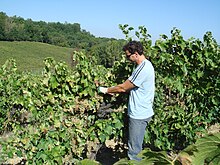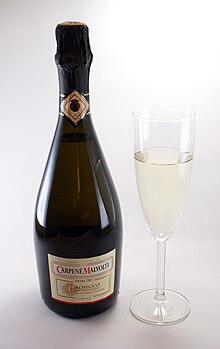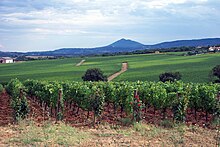
Italian wine (Italian: vino italiano) is produced in every region of Italy. Italy is the country with the widest variety of indigenous grapevine in the world,[1][2] with an area of 702,000 hectares (1.73 million acres) under vineyard cultivation,[3] as well as the world's second largest wine producer and the largest exporter as of 2023[update].[4][5] Contributing 49.8 million hl of wine in 2022, Italy accounted for over 19.3% of global production, ahead of France (17.7%) and Spain (13.8%);[5][6] the following year, production decreased by 11.5 million hl, and Italy was surpassed by France.[4] Italian wine is also popular domestically among Italians, who consume a yearly average of 46.8 litres per capita, ranking third in world wine consumption.[7]
The origins of vine-growing and winemaking in Italy has been illuminated by recent research, stretching back even before the Phoenician, Etruscans and Greek settlers, who produced wine in Italy before the Romans planted their own vineyards.[8] The Romans greatly increased Italy's viticultural area using efficient viticultural and winemaking methods.[9]

Vines have been cultivated from the wild Vitis vinifera grape for millennia in Italy. It was previously believed that viticulture had been introduced into Sicily and southern Italy by the Mycenaeans,[11] as winemaking traditions are known to have already been established in Italy by the time the Phoenician and Greek colonists arrived on Italy's shores around 1000–800 BC.[12][13] However, archeological discoveries on Monte Kronio in 2017 revealed that viticulture in Sicily flourished at least as far back as 4000 BC — some 3,000 years earlier than previously thought.[14] Also on the peninsula, traces of Bronze Age and even Neolithic grapevine management and small-scale winemaking might suggest earlier origins than previously thought.[15]
Under ancient Rome large-scale, slave-run plantations sprang up in many coastal areas of Italy and spread to such an extent that, in AD 92, Emperor Domitian was forced to destroy a great number of vineyards in order to free up fertile land for food production.

During this time, viticulture outside of Italy was prohibited under Roman law. Exports to the provinces were reciprocated in exchange for more slaves, especially from Gaul. Trade was intense with Gaul, according to Pliny, because the inhabitants tended to drink Italian wine unmixed and without restraint.[16] Although unpalatable to adults, it was customary, at the time, for young people to drink wine mixed with a good proportion of water.
As the laws on provincial viticulture were relaxed, vast vineyards began to flourish in the rest of Europe, especially Gaul (present-day France) and Hispania. This coincided with the cultivation of new vines, such as biturica, an ancestor of the Cabernets. These vineyards became so successful that Italy ultimately became an import centre for provincial wines.[9]
Depending on the vintage, modern Italy is the world's largest or second-largest wine producer. In 2005, production was about 20% of the global total, second only to France, which produced 26%. In the same year, Italy's share in dollar value of table wine imports into the U.S. was 32%, Australia's was 24%, and France's was 20%. Along with Australia, Italy's market share has rapidly increased in recent years.[17]

In 1963, the first official Italian system of classification of wines was launched. Since then, several modifications and additions to the legislation have been made, including a major modification in 1992. The last modification, which occurred in 2010, established four basic categories which are consistent with the latest European Union wine regulations (2008–09). The Italian Ministry of Agriculture (MIPAAF) regularly publishes updates to the official classification.[18][19] The categories, from the bottom to the top level, are:

Important wine-relevant geographic characteristics of Italy include:
The main wine production areas in Italy, with the wine-growing areas, the main vines (the native ones in italics) and the main wines produced:
| Region | Wine-growing region | Main grape varieties | Main wines |
|---|---|---|---|
| Valle d'Aosta DOC | |||
| Nero di Troia | Primitivo di Manduria | ||
| Vulture | Aglianico del Vulture | ||
| Collio Goriziano | |||
| Frascati | Frascati DOC | ||
| Valtellina |
| ||
| Franciacorta | Franciacorta DOCG | ||
| Oltrepò Pavese | |||
| Langhe |
| ||
| Roero | Barbera | Roero Arneis | |
| Montferrat | Dolcetto | Barbera del Monferrato | |
| Grignolino | |||
| Pelaverga | Verduno Pelaverga | ||
| Ruché di Castagnole Monferrato | |||
| Cortese | Gavi | ||
| Canavese | Erbaluce |
| |
| Dolcetto di Dogliani | |||
| Chianti | Sangiovese | ||
| Montefalco | Montefalco Sagrantino | ||
| Bovale |
| ||
| Colline del Prosecco di Conegliano e Valdobbiadene | Glera | Prosecco | |
| Valpolicella |
|
See also: List of Italian grape varieties |
Italy is the country with the widest variety of indigenous grapevine in the world.[1][2] Italy's Ministry of Agriculture and Forestry (MIPAAF), has documented over 350 grapes and granted them "authorized" status. There are more than 500 other documented varieties in circulation as well. The following is a list of the most common and important of Italy's many grape varieties.


Other important whites include Carricante, Coda de Volpe, Cortese, Falanghina, Grechetto, Grillo, Inzolia, Picolit, Traminer, Verduzzo, and Vernaccia.



Other major red varieties are Cannonau, Ciliegiolo, Gaglioppo, Lagrein, Lambrusco, Monica, Nerello Mascalese, Pignolo, Refosco, Schiava, Schioppettino, Teroldego, and Uva di Troia.

The term Super Tuscan (mostly used in the English-speaking world and less known in Italy)[26] describes any wine (mostly red, but sometimes also white) produced in Tuscany that generally does not adhere to the traditional local DOC or DOCG regulations. As a result, Super Tuscans are usually Toscana IGT wines, while others are Bolgheri DOC, a designation of origin rather open to international grape varieties. Traditional Tuscan DOC(G)s require that wines are made from native grapes and mostly Sangiovese. While sometimes Super Tuscans are actually produced by Sangiovese alone, they are also often obtained by (1) blending Sangiovese with international grapes (such as Cabernet Sauvignon, Merlot, Cabernet Franc, and Syrah) to produce red wines, (2) blending international grapes alone (especially classic Bordeaux grapes for reds; Chardonnay and Sauvignon blanc for whites), or (3) using one single international variety.


Although an extraordinary amount of wines claim to be "the first Super Tuscan", most would agree that this credit belongs to Sassicaia, the brainchild of marchese Mario Incisa della Rocchetta, who planted Cabernet Sauvignon at his Tenuta San Guido estate in Bolgheri back in 1944. It was for many years the marchese's personal wine, until, starting with the 1968 vintage, it was released commercially in 1971.[27]
In 1968 Azienda Agricola San Felice produced a Super Tuscan called Vigorello, and in the 1970s Piero Antinori, whose family had been making wine for more than 600 years, also decided to make a richer wine by eliminating the white grapes from the Chianti blend, and instead, adding Bordeaux varietals (namely, Cabernet Sauvignon and Merlot). He was inspired by Sassicaia, of which he was given the sale agency by his uncle Mario Incisa della Rocchetta. The result was one of the first Super Tuscans, which he named Tignanello, after the vineyard where the grapes were grown. What was formerly Chianti Classico Riserva Vigneto Tignanello, was pulled from the DOC in 1971, first eliminating the white grapes (then compulsory in Chianti DOC) and gradually adding French varieties. By 1975, Tignanello was made with 85% Sangiovese, 10% Cabernet Sauvignon, and 5% Cabernet Franc, and it remains so today.[27]
Because these wines did not conform to strict DOC(G) classifications, they were initially labelled as vino da tavola (lit. 'table wine'), an old official category ordinarily reserved for lower quality wines. The creation of the indicazione geografica tipica category (technically indicating a level of quality between vino da tavola and DOC(G)) in 1992 and the DOC Bolgheri label in 1994 helped bring Super Tuscans "back into the fold" from a regulatory standpoint. Since the pioneering work of the Super Tuscans, there has been a rapid expansion in the production of high-quality wines throughout Italy that do not qualify for DOC or DOCG classification.
Many international wine guides and wine publications rate the most popular Italian wines. Among the Italian publications, Gambero Rosso is probably the most influential. In particular, the wines that are annually given the highest rating of "three glasses" (Tre Bicchieri) attract much attention. Recently, other guides, such as Slow Wine, published by Slow Food Italia, and Bibenda, compiled by the Fondazione Italiana Sommelier, have also gained attention both among professionals and amateurs.

Vino cotto (lit. 'cooked wine') is a form of wine from the Marche and Abruzzo regions of central Italy. It is typically made by individuals for their own use as it cannot legally be sold as wine. The must, from any of several local varieties of grapes, is heated in a copper vessel where it is reduced in volume by up to a third before fermenting in old wooden barrels. It can be aged for years, barrels being topped up with each harvest. The Marche authorities have set down a specification for the method of production of vino cotto.[28]
Vincotto, typically from Basilicata and Apulia regions, also starts as a cooked must but is not fermented, resulting in a sweet syrup suitable for the preparation of sweets and soft drinks. In Roman times it was known as sapa in Latin and epsima in Greek, the same names that are often used for it, respectively, in Italy and Cyprus.[29]